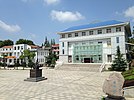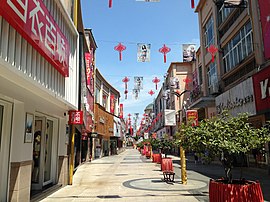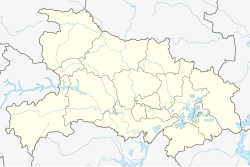Huanggang
黄冈市 Hwangkang | |
|---|---|
Clockwise: Huanggang skyline, Li Siguang Memorial Museum, Shopping street in Huangzhou, Mount Tashan near Fengshan. | |
 Location of Huanggang City jurisdiction in Hubei | |
| Coordinates (Huanggang municipal government): 30°27′13″N 114°52′21″E / 30.4537°N 114.8724°E | |
| Country | People's Republic of China |
| Province | Hubei |
| Municipal seat | Huangzhou District |
| Area | |
| 17,446.63 km2 (6,736.18 sq mi) | |
| • Urban | 363.23 km2 (140.24 sq mi) |
| • Metro | 963.44 km2 (371.99 sq mi) |
| Population (2020 census)[2] | |
| 5,882,719 | |
| • Density | 340/km2 (870/sq mi) |
| • Urban | 456,862 |
| • Urban density | 1,300/km2 (3,300/sq mi) |
| • Metro | 1,152,559 |
| • Metro density | 1,200/km2 (3,100/sq mi) |
| GDP[3] | |
| • Prefecture-level city | CN¥ 158.9 billion US$ 25.5 billion |
| • Per capita | CN¥ 25,319 US$ 4,065 |
| Time zone | UTC+8 (China Standard) |
| ISO 3166 code | CN-HB-11 |
| Local Dialect | Lower Yangtze Mandarin |
| Website | 黄冈市政府门户网站 (Huanggang City Government Web Portal) (in Chinese) |
| Huanggang | |||||||||||
|---|---|---|---|---|---|---|---|---|---|---|---|
| Simplified Chinese | 黄冈 | ||||||||||
| Traditional Chinese | 黃岡 | ||||||||||
| |||||||||||
Huanggang is a prefecture-level city in easternmost Hubei Province, China. It is situated to the north of the middle reaches of the Yangtze River and is bounded in the north by the Dabie Mountains and is named after Mount Huanggang.[1] It borders Henan in the north, Anhui in the east and Jiangxi in the south.
The city's administrative area covers 17,453 square kilometers (6,739 sq mi) and the total population was 5,882,719 as of the 2020 census whom 456,862 resided in the Huangzhou urban district, making it the second most populous city in the province by administrative population, after Wuhan,[4] the provincial capital. the Ezhou – Huanggang built-up (or metro) area was home to 1,152,559 inhabitants comprising (Echeng district and Huangzhou district of Huanggang), and many of its residents work in Wuhan.[4] In 2007, the city is named China's top ten livable cities by Chinese Cities Brand Value Report, which was released at the 2007 Beijing Summit of China Cities Forum.[5]
- ^ a b 辭海第六版 [Cihai (Sixth Edition)]. Shanghai: Shanghai Lexicographical Publishing House. September 2009. p. 957. ISBN 9787532628599.
- ^ "China: Húbĕi (Prefectures, Cities, Districts and Counties) – Population Statistics, Charts and Map".
- ^ 湖北省统计局、国家统计局湖北调查总队 (August 2016). 《湖北统计年鉴-2016》. 中国统计出版社. ISBN 978-7-5037-7847-6. Archived from the original on 1 March 2017. Retrieved 5 June 2017.
- ^ a b 湖北黄冈9个县市确诊病例全部“清零”. Xinhua. 14 March 2020. Archived from the original on 14 March 2020. Retrieved 21 March 2020.
- ^ "China's Top 10 Most Livable Cities". hnloudi.gov.cn. Hunan Loudi Official Government. 28 March 2012. Archived from the original on 10 April 2013. Retrieved 4 August 2014.





